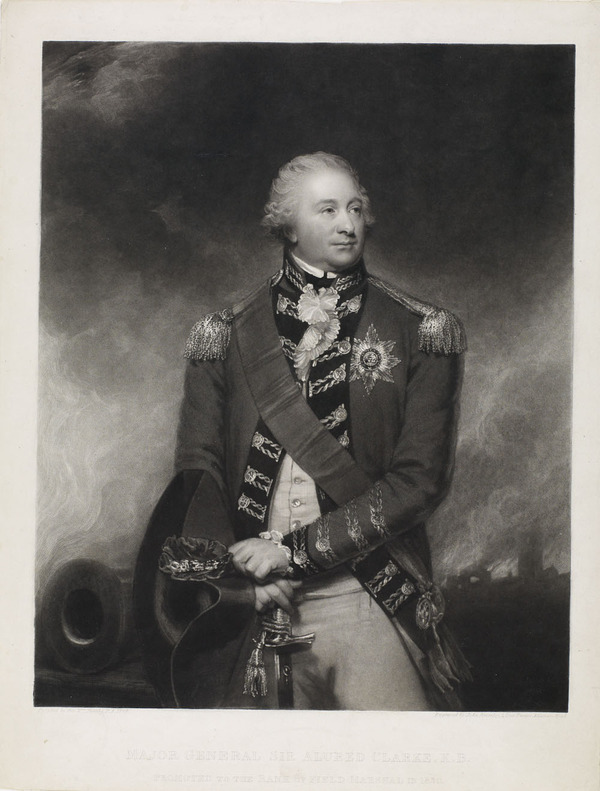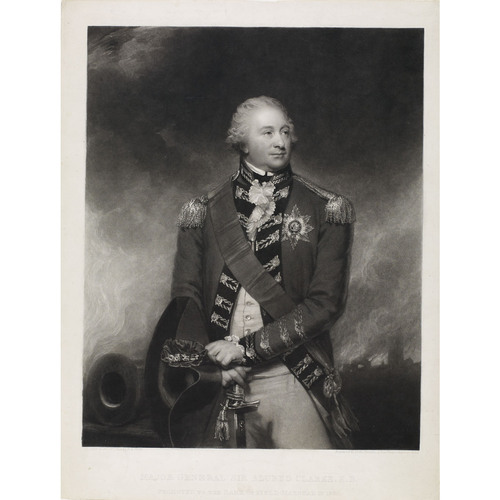CLARKE, Sir ALURED, army officer and colonial administrator; b. c. 1745, possibly the son of Charles Clarke, baron of the Exchequer in England, and his second wife, Jane Mullins; d. unmarried 16 Sept. 1832 in Llangollen, Wales.
Alured Clarke obtained an ensigncy in the 50th Foot in 1759 and six years later became a captain in the 5th Foot. After being made major in the 54th Foot in 1771, he was promoted lieutenant-colonel in 1775. He proceeded with that regiment to New York the following year. In 1777 he assumed command of the 7th Foot, and he served with it until he became muster master general of the German troops in succession to John Burgoyne*; in 1782 he became a colonel. Between that year and 1790 he was lieutenant governor of Jamaica, where he enjoyed great popularity with the planters and earned the approbation of Home Secretary Lord Grenville. Having been raised to the rank of major-general, Clarke was promoted colonel of the 1st battalion, 60th Foot, in July 1791.
On 19 March 1790 Clarke had been appointed lieutenant governor of the province of Quebec in succession to Henry Hope*. He arrived at Quebec on 7 October and assumed his responsibilities the following day. On the departure of Governor Lord Dorchester [Guy Carleton*] for Britain in August 1791, Clarke took over command of the British forces in North America and the administration of what that month became the province of Lower Canada. His major task as civil administrator was to put into operation the provisions of the Constitutional Act of 1791, an undertaking that necessitated action by the local executive on a variety of administrative matters before the new legislature could be called into session.
The exact definition of geographical boundaries, not only between Lower and Upper Canada but also with the United States, presented Clarke with a tangled problem because of discrepancies in the wording of various instruments and instructions he received from London. Determining the boundary with the United States was a particularly sensitive issue, Anglo-American relations having remained delicate since Britain had decided to retain possession of certain posts on the American side of the Great Lakes, contrary to the terms of the peace treaty of 1783. Moreover, Indian tribes in the Ohio region, angered by Britain’s promised cession of territory south of the lakes to the Americans, posed a constant threat to peace and stability on the frontier. Clarke could only attempt to avoid conflicts in the Indian territory; settling the disposition of the posts was a matter of diplomatic negotiation between the British and American governments and was finally decided in 1794 by Jay’s Treaty.
Within Lower Canada, on the basis of general guidelines from London and perhaps the specific advice of local officials, Clarke issued a proclamation on 7 Feb. 1792 that laid down the terms for granting crown lands in the province. To attract settlers and reward loyalists, a maximum of 200 acres, to which the head of the administration might add up to 1,000 acres, was offered to each petitioner who would give assurances of cultivating the land, take an oath of loyalty, and pay the stipulated fees to officials. With such open-handed generosity, the land committee of the newly created Executive Council was soon deluged with claims, which took years to process, Clarke alone issuing warrants for the survey of 150 townships comprising some 7,000,000 acres. Large tracts of land would be monopolized by speculators and government officials through the system of township leaders and associates [see Samuel Gale] to the detriment of bona fide settlers and the province’s economic development. Another source of inconvenience and controversy was the reservation of one-seventh of each township for the support of a Protestant clergy and an additional one-seventh as crown lands from which the local executive might eventually derive a revenue free from the assembly’s control. More unwisely still for the future, Clarke’s original plan of setting up both crown and clergy reserves as a single block in each township was rejected in London in favour of a scheme that would scatter them through the townships in 200-acre lots according to a chequered pattern and thus intersperse them even more inconveniently among grants to individuals.
Institutional adjustments to the new constitutional order involved reorganization of the courts of justice and establishment of an executive council, which would be a court of appeal among other things. As a preliminary to summoning the Lower Canadian legislature, Clarke issued a proclamation on 7 May 1792 that divided the colony into counties, cities, and boroughs, constituting electoral districts, and apportioned 50 representatives among them. With this potentially controversial issue settled to the general satisfaction of the colonists, provincial elections were held that year. In December Clarke proudly opened the first legislature of Lower Canada, which met in the bishop’s palace at Quebec. Since he spoke no French, and many representatives no English, his address to the House of Assembly and the Legislative Council was repeated by a translator. Clarke’s report on the functioning of the assembly to the new home secretary, Henry Dundas, described conditions that in general would plague its operations for years to come. “Upon the first meeting of the Legislature,” he informed Dundas, “a Spirit of Jealousy and some animosity discovered itself,” arising from the Canadians’ fear that, although they held a comfortable majority, the British members would control the assembly and use it to change the laws and customs of the colony. The Canadians insisted on and obtained a high quorum of 34 to ensure that no bill would pass unless a majority of them accepted it. As well, they were determined that a Canadian must occupy the key post of speaker and voted Jean-Antoine Panet* into the chair. They also initially attempted to establish French as the enacting language, but ultimately all bills were passed in English; had a piece of legislation reached Clarke in French, he assured Dundas, he would have reserved sanction. Combined with the atmosphere of suspicion that reigned in the assembly, the high quorum effectively blocked the entire legislative process until the last month. Many members having departed in frustration to attend to their private concerns, it was feared that “the Session would close in a very unseemly manner,” with virtually no legislation completed. The quorum was reduced and business conducted briskly until eight bills had been passed, including one granting Quakers exemption from militia service and from the oath of allegiance. By that time spring was so advanced that nothing could keep the remaining legislators away from their personal affairs, and Clarke prorogued the session on 9 May 1793.
The whirlwind end of session gave Clarke grounds for optimism: “The Canadian Members having, as they conceived, established their consequence” by demonstrating to the people that they could act together to control the assembly, and the British members having demonstrated moderation, “the invidious distinctions that at first appeared, had previous to the Prorogation, in great measure vanished; and . . . all the Members, New and Old Subjects, who remained in Town, dined together on the last day of the Session, and parted in the greatest harmony and good humour with each other.” Consequently, although the amount of legislation passed had been meagre, Clarke considered “that as much has been done as could reasonably be expected” and was confident that the experience acquired by the members of the assembly would enable them to act more effectively in future.
Following Dorchester’s return to Quebec in September 1793, Clarke gladly departed, probably in November, for England, where he had spent only some five months during the previous 20 years. Dundas had earlier expressed his “compleat satisfaction” with Clarke’s service and promised “more effectually to demonstrate the opinion I entertain of your merit.” There had been talk of Clarke’s being appointed governor of Jamaica, but he remained lieutenant governor of Lower Canada until 1795. Meanwhile, in 1794 he had transferred successively to the colonelcies of the 68th Foot and the 5th Foot. That year Dundas became secretary for war, and perhaps he kept his promise in 1795 when Clarke was chosen to command a body of reinforcements bound for India. He stopped en route to assist in the capture of the Dutch colony at the Cape of Good Hope (South Africa). In India he was promoted to the local rank of lieutenant-general in 1796 and received the full rank in January 1797. After being commander-in-chief of Madras, in 1797 he transferred to the same post in Bengal, where he also served as president and senior councillor; that year he was made a kb. In September he was appointed governor general of India, but he resigned in 1798 to become commander-in-chief of the British forces there, a position he held until 1801.
Back in England that year, Clarke transferred to the colonelcy of the 7th Foot in August, and in 1802 he rose to the rank of general; he was ultimately made field marshal in 1830. The promotion was a fitting, if belated, tribute to a professional soldier whose modest talents and courteous manner had enabled him to discharge the civil duties of a colonial administrator without either distinguishing or disgracing himself.
PAC, MG 23, GII, 10, vol.3: 724–27, 732–37; MG 30, D1, 8: 359–83. PRO, CO 42/73–98; CO 43/16. Corr. of Lieut. Governor Simcoe (Cruikshank). Docs. relating to constitutional hist., 1791–1818 (Doughty and McArthur), 54–82, 107–16. “Quelques prêtres français en exil au Canada,” ANQ Rapport, 1966: 144, 158, 168. Quebec Gazette, 29 Aug., 8 Sept., 10, 24 Nov. 1791; 5 Jan., 9, 23 Feb., 1 March, 10, 17 May, 12 July, 16 Aug., 20 Sept., 18 Oct., 27 Dec. 1792; 24 Jan., 25 April, 2, 16 May, 31 Oct. 1793. Times (London), 20 Sept. 1832. DNB. G.B., WO, Army list, 1759–1832. Morgan, Sketches of celebrated Canadians, 113–14. Wallace, Macmillan dict. Caron, La colonisation de la prov. de Quebec, 2: 11–55. Christie, Hist. of L.C. (1848–55), vol.1.
Cite This Article
Peter Burroughs, “CLARKE, Sir ALURED,” in Dictionary of Canadian Biography, vol. 6, University of Toronto/Université Laval, 2003–, accessed March 31, 2025, https://www.biographi.ca/en/bio/clarke_alured_6E.html.
The citation above shows the format for footnotes and endnotes according to the Chicago manual of style (16th edition). Information to be used in other citation formats:
| Permalink: | https://www.biographi.ca/en/bio/clarke_alured_6E.html |
| Author of Article: | Peter Burroughs |
| Title of Article: | CLARKE, Sir ALURED |
| Publication Name: | Dictionary of Canadian Biography, vol. 6 |
| Publisher: | University of Toronto/Université Laval |
| Year of revision: | 1987 |
| Access Date: | March 31, 2025 |




